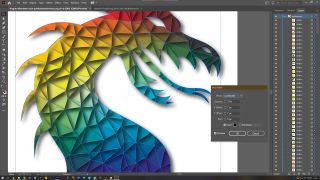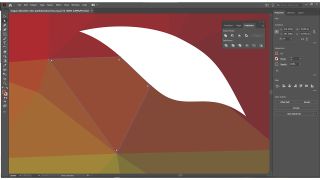To understand Adobe Illustrator CC, you need to know more about Adobe’s Creative Suite, which includes Photoshop, Illustrator and InDesign. Each of these programs handles a different part of digital art and graphic design. Adobe encourages graphic designers to use all three programs to get the best results.
Photoshop is best for photo editing and digital painting, as it works with pixels and offers image-enhancing tools. Illustrator works with vectors to create images that can scale to any size without becoming pixelated, making it ideal for logos and banners. And InDesign is desktop publishing software that helps you place text and imagery onto pages for publication. You don’t have to use all of these programs to create design projects, but it’s best to know that they are intended to work together.

Illustrator has all of the vector tools you need, and then some. This large selection can be daunting at first, but once you know what all of the tools do, you’ll find that it offers the greatest creative freedom of any vector-based graphic design software. There are pen tools, vector brushes, the ability to create custom brushes, and plenty of text tools to help make your designs stand out. For symmetry and balance, use the guides, grids and rulers to make sure everything lines up. We love the way Illustrator responds to tablets; we saw pressure sensitivity in each stroke and could control the way the lines looked.
Image tracing is an excellent time-saving feature. To use it, import a raster image into the program, and choose Image Trace. The raster image will be turned into a vector. From there, select the image, and click Expand. This will make it an editable vector image. It isn’t always perfect, and you will likely need to touch up the converted image, but it saves you a ton of time.

Adobe Illustrator review: Features
Although you can import images and use content-aware scaling in Illustrator, the program is not designed to make pixel adjustments to photos. This means the software lacks filters, HDR imaging tools, panorama stitching, color correction, noise removal and automatic lens correction. Adobe intends Photoshop to handle those tasks. Illustrator comes with 15 free templates, and you can buy more in Adobe Stock, an online royalty-free library of images, graphics and vectors.
Illustrator provides masking tools, which allow you to add or remove elements from your design to make it look more dynamic. There is also perspective-based editing and the ability to create animated GIFs. In addition, Illustrator has batch processing, which lets you apply the same effects to multiple documents at once – a feature that saves you time when working on big projects.

Adobe Illustrator review: Compatibility and Export Options
Illustrator handles most file types, including JPEG, GIF, PNG, TIF, BMP, SVG and AI. You cannot save files as PSDs, and the software doesn’t work with RAW or XLS files. Illustrator is available for both Mac and PC. Adobe Illustrator Draw, a tablet app, is also available for iPad and Android devices.
This software provides everything you need for your printed projects to turn out just the way you envision them. Use the bleed setup to ensure no unwanted white space makes its way onto your physical creations. You can also add printer’s marks, making it easier to know where to cut the paper once it’s been printed. Should anything be off, Illustrator will warn you before sending your file to the printer.
Adobe Illustrator review: Price and Support Options
As with the other programs in Adobe’s Creative Cloud, Illustrator requires a subscription, which costs either $20.99 per month or $239.88 per year. Adobe offers a free trial period, but it’s only seven days, which is much shorter than the 30-day average. If you’d prefer a powerful program that is much more affordable, we recommend Affinity Designer and the other Affinity apps.
Adobe has one of the largest support databases of any graphic design software. If you want tips from pros, simply go onto the official user forum or one of the many fan-created user forums. Because this is such a popular program, you’ll also find hundreds, if not thousands, of video tutorials created both by Adobe and pro users. You can contact Adobe via email and live chat if you need further assistance.
Should you buy Adobe Illustrator?
Illustrator is the industry standard for vector-based graphic design software. It’s super-powerful and creates quality effects and vector elements. If you need pixel brush tools and photo touch-up tools, however, you’ll need a photo editing software, and maybe some of the best graphic design software too. The subscription requirement is probably the biggest drawback, but if you’re willing to pay, you’ll have access to some of the most powerful vector tools on the market.

